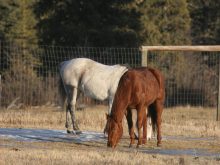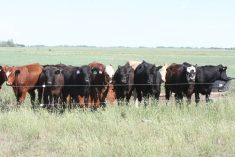Many younger producers and veterinarians have not seen lumpy jaw or wooden tongue, even though both still exist.
Treatment is the same for both conditions and prognosis is good.
The bacteria that causes lumpy jaw causes changes to the jaw bone. You can get rid of the infection, but not the changes. However, as long as it doesn’t worsen and the cattle can eat properly, it should have little effect and the swelling can remain until the animals go to the packing plant.
Bulls, too, can be treated and continue in the breeding herd until their usefulness as a herd sire is done. Monitor them to ensure they pass their semen tests every year as normal. I have seen many bulls with a recovered lumpy jaw continue breeding.
Read Also

Charges laid after cattle theft
Saskatchewan RCMP lay two charges against a man after six cattle went missing.
Speed is of the essence when treating lumpy jaw, or the swelling will keep growing and then break open. Plus, the yellow liquid that often drains out later in the infection is full of the actinomycosis organisms, which may spread and cause other cases.
Wooden tongue is seen much less frequently. I recently watched a video of a cow that had wooden tongue. It had a thickened tongue sticking out of its mouth, lots of salivation and appeared to have difficulty eating.
Veterinarians will usually examine the animal’s mouth with what we call a drink-water gag, which is placed between the molars on one side of the mouth.
You need to rule out other causes, such as a lacerated tongue infection from barley beards or thorny plants.
Treatment for both conditions involves antibiotics. I recently have used tetracycline but practitioners have used other antimicrobials.
As well, sodium iodide is sometimes used. The product deserves talking about because it is not in common use in veterinary medicine. It is on the label for wooden tongue, lumpy jaw and necrotic stomatitis, also known as calf diptheria. It can also be used in iodine deficiency because the chemical formula is NaI, so there is iodine in it.
We must be careful because it comes with a warning label that it could cause abortions. However, in many instances, we have no choice but to use it and take our chances. When I have used it over the years, I don’t recall ever hearing of an abortion.
It wasn’t available for a while in Canada because the product had been dropped, but another company in Calgary is manufacturing it now on an as-needed basis. Most decent-sized large animal clinics keep a few bottles in inventory.
Another potential problem with it is it must be given slowly intravenously and it is extremely irritating if it gets outside the vein.
In practice, I should have used it more in calves with necrotic stomatitis. Calf diptheria cases are rare these days, but sodium iodide may help when they arise.
Sodium iodide also acts as a carrier moving the antibiotic into the source of infection, so it is a great benefit to the above-mentioned conditions.
Veterinarians may also use it when they have a cellulitis case, an infection that instead of getting walled off and forming an abscess spreads through the tissue. Cattle become very sick and it quickly spreads.
Sodium iodide, if given with an antibiotic, may help get the infection under control. This condition is rare in cattle because they have a great ability to wall off infections, whether internally in the abdomen or externally in the musculature.
This is why we talk about when and how to flush abscesses. They are non-life threatening, unless they get enormous or rupture into vital systems. There is usually time to wait so you can lance them at the right time. As well, they can be left as blemishes if there is little pus in them.
Most times, lumpy jaw and wooden tongue cases can be treated successfully and affected animals can be kept in the herd. You can ship lumpy jaw cases to slaughter before treatment, but treatment will stop the lumpy jaw from becoming worse in most instances.
Valuable breeding females and breeding bulls can live out their productive lives.
Ask your veterinarians about sodium iodide for other treatments, such as for calf diphtheria. Sodium iodide is not that expensive. In rare cases a second treatment may be necessary.
It is a product that is not commonly used, but hopefully your veterinarian will keep some inventory. There is no slaughter withdrawal time requirement, only a milk withdrawal time.
Roy Lewis works as a veterinarian in Alberta.

















